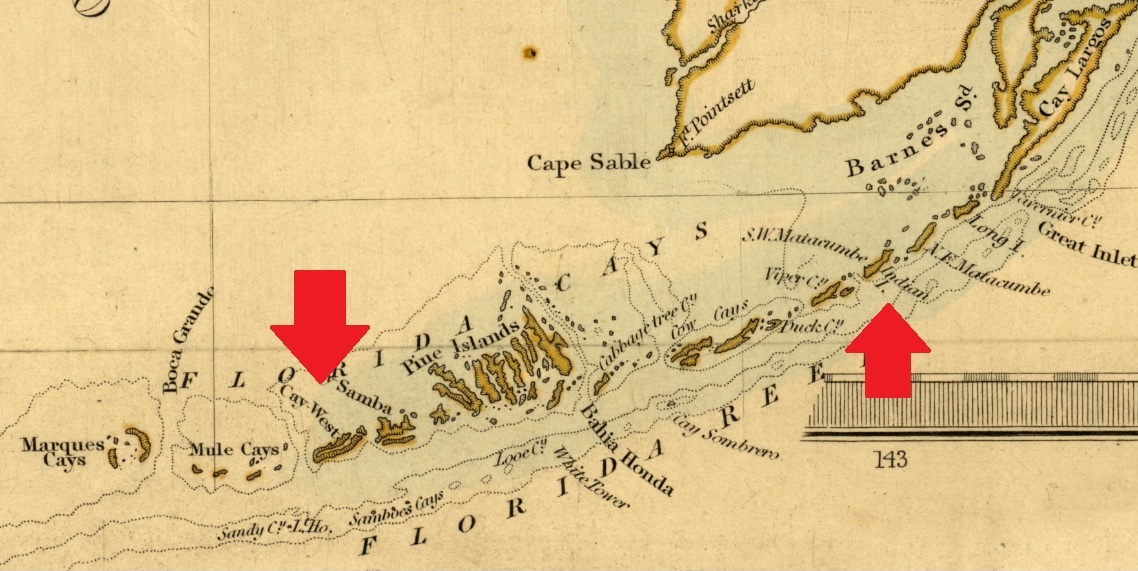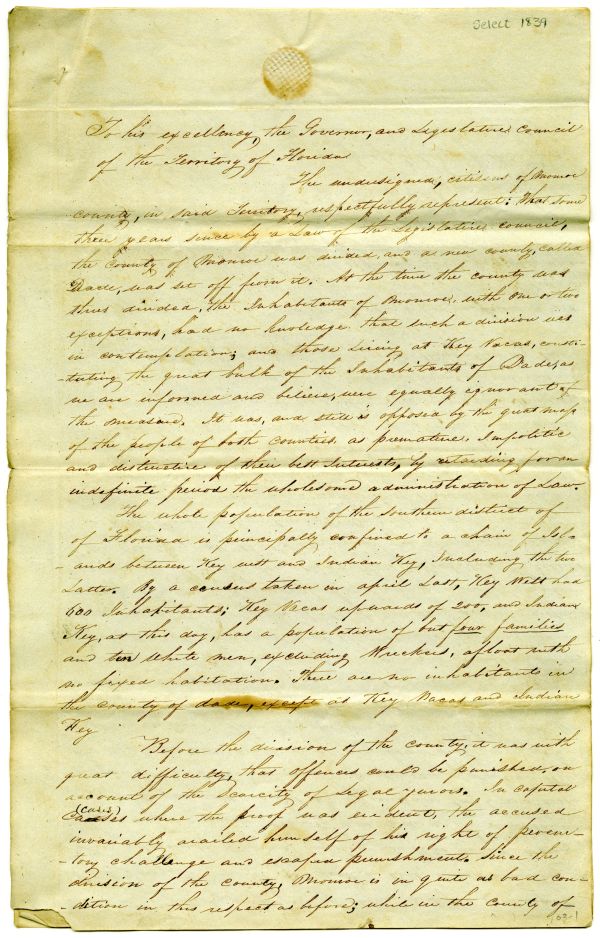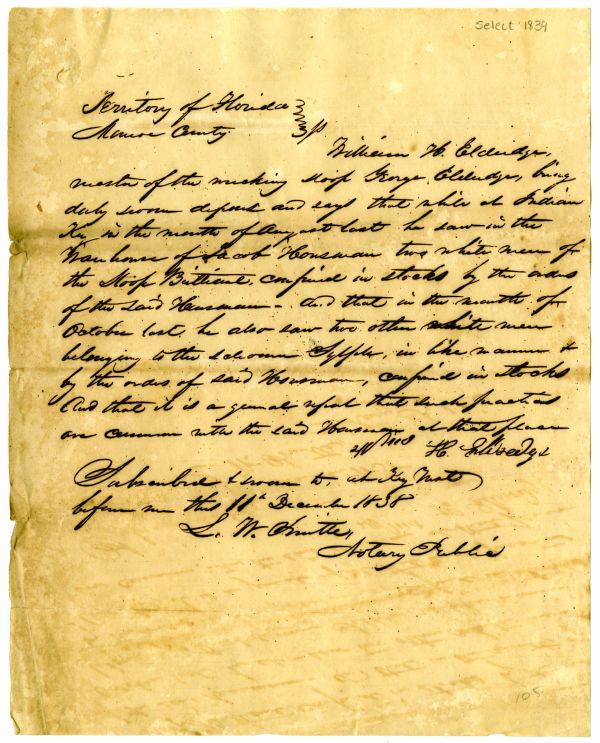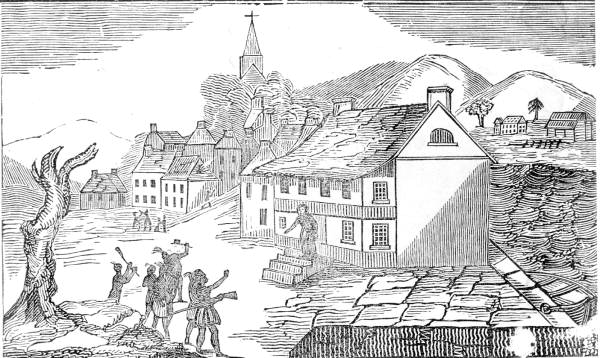Description of previous item
Description of next item
Jacob Housman: Florida's Lawless Frontiersman
Published July 7, 2020 by Florida Memory
When Ralph Waldo Emerson arrived in newly established Tallahassee in 1827, he called it “a grotesque place… rapidly settled by public officers, land speculators and desperados.” Emerson's quote could well have described lots of places in the new Florida Territory at that time. Outside the better established cities of Pensacola and St. Augustine, Florida looked a lot like America's fabled western frontier: a land of settlers, indigenous peoples, vigilante justice and more than a few cases of corruption. Only the aesthetic was changed. Instead of sprawling deserts or the Rocky Mountains, there were endless swamps, sandhills and pine barren keys. Nothing illustrates this "southern" version of the West better the case of the swashbuckling wrecker Jacob Housman.

Engraving of a typical wrecker in the Florida Keys from Harper's New Monthly Magazine, vol. 18 (1858-1859), 577.
During Florida’s territorial period, Key West became a center for wrecking—the business of salvaging shipwrecks. Serving as the county seat of Monroe County, the town was a small but bustling commercial and government center crammed onto a tiny island. Jacob Housman was a native of New York who started his illustrious career by stealing a boat from his father. After finding his way to Florida and discovering that the lucrative wrecking business in Key West was already saturated, Housman sought to challenge the supremacy of the established wreckers and even the local county government. Housman began buying property and assets on nearby Indian Key, soon gaining control of the entire island. He built a store, houses, a hotel and other amenities and established a wrecking business of his own. But he didn't stop there. Housman successfully petitioned the territorial government to create Dade County out of a portion of Monroe County and make Indian Key the county seat. A courthouse and post office were soon built on the island.

Excerpt from an 1843 map of Florida drawn by Henry Schenk Tanner showing the relative locations of Key West and Indian Key. Click or tap the image to view a zoomable version of the complete map.
From the time it was created by the territorial legislative council, Housman treated the Dade County government as his own personal fiefdom. Petitioners from neighboring Monroe County complained that he had turned the island into a dictatorship, wielding both executive and judicial authority over everyone who lived there or visited. The county judge, they said, had appointed election inspectors who were "notoriously the tools of himself and the proprietor of Indian Key," meaning Housman. The way the petitioners described things, it looked as though Indian Key was quickly devolving into that paradise for desperados and corrupt public officials that Emerson had written about. As for the petitioners, they recommended the law creating Dade County be repealed entirely, or that the legislative council at least stop Dade from hosting sessions of the superior court, which had authority to affect matters in Monroe County as well.

Petition requesting the repeal of the law creating Dade County, ca. 1839. Click or tap the image to view the complete document with transcript.
Around that same time, more disturbing evidence of Housman's behavior reached legislators in the form of affidavits asserting that he had held prisoners in stocks in his warehouse for many days under deplorable conditions. Two wreckers, William Eldridge and John Sitcher, reported seeing this spectacle on multiple occasions, with the prisoners being given no bedding or mosquito netting, and only "biscuit and water" to sustain them.

Affidavit from William H. Eldridge attesting to Jacob Housman's treatment of prisoners on Indian Key. Click or tap the image to view the this plus another similar affidavit, both with transcripts.
Jacob Housman's island empire ended up being short-lived. The Second Seminole War broke out in 1835, and even with the protection of naval vessels patroling the area, the conflict eventually reached as far as the Florida Keys. Natives attacked Indian Key in 1840, prompting most of the inhabitants to flee. Around 13 residents were killed in the fray, and most of the buildings and equipment from Housman's wrecking business were burned to the ground. Housman himself escaped but died in a shipping accident the following year.

A drawing of Indian Key adapted from "The Pathetic and Lamentable Narrative of Miss Perrine on the Massacre and Destruction of Indian Key Village in Aug. 1840."
As for Indian Key, it fell into disrepair. The Navy took it over for a while during the final stages of the Second Seminole War, but then it became a ghost town, much like the ghost towns of the Old West. The county seat for Dade County was moved to Miami in 1844, and the upper Keys, including Indian Key, were restored to Monroe County. Today, the island is a state park. Some evidence of Housman's notorious reign is still visible, including the public square he established in the middle of the island.
Cite This Article
Chicago Manual of Style
(17th Edition)Florida Memory. "Jacob Housman: Florida's Lawless Frontiersman." Floridiana, 2020. https://www.floridamemory.com/items/show/345947.
MLA
(9th Edition)Florida Memory. "Jacob Housman: Florida's Lawless Frontiersman." Floridiana, 2020, https://www.floridamemory.com/items/show/345947. Accessed March 25, 2025.
APA
(7th Edition)Florida Memory. (2020, July 7). Jacob Housman: Florida's Lawless Frontiersman. Floridiana. Retrieved from https://www.floridamemory.com/items/show/345947

 Listen: The Folk Program
Listen: The Folk Program
